If you’re considering purchasing a new bicycle, whether it’s your very first bike or an upgrade, understanding the crucial measurements that define its frame geometry is essential. This knowledge ensures you select a machine that not only fits you perfectly but also aligns with your intended riding style and terrain. Similarly, if you’re planning to rent a bike, knowing your ideal frame measurements empowers you to confirm that your rental will provide a comfortable and efficient riding experience, adjustable to your specific needs.
Bike manufacturers don’t always adhere to uniform sizing conventions. What one brand labels as a ‘medium’ might differ significantly from another. Therefore, focusing on fundamental frame measurements is vital to make accurate comparisons and ensure you’re truly comparing apples to apples when assessing different bikes.
This comprehensive guide will walk you through the process of measuring your road bike or mountain bike frame. Mastering these techniques will empower you to determine the right bike fit and confidently navigate your bike purchasing or renting decisions. For a deeper dive into how these measurements directly influence a bike’s handling characteristics, explore our detailed guide to mountain bike geometry. While focused on mountain bikes, the principles of these measurements largely apply to road bikes as well.
We also offer specific guidance on selecting the correct frame size for road bikes and mountain bikes, along with tailored advice for choosing the right women’s bike.
Understanding Key Bike Frame Measurements
Before we delve into the practical steps of measuring your bike frame, let’s familiarize ourselves with the essential measurements you’ll be working with. These dimensions are the building blocks of bike geometry and dictate how a bike will feel and perform.
Here’s a rundown of key bike geometry measurements:
- Top Tube Length (Effective): The horizontal distance from the center of the head tube to the center of the seatpost. This is often referred to as the virtual top tube length and is crucial for determining the bike’s reach.
- Seat Tube Length: The distance measured along the seat tube from the center of the bottom bracket to the top of the seat tube. Historically used for sizing, but less critical now than reach and stack.
- Reach: The horizontal distance from the center of the bottom bracket to the top center of the head tube. Reach is a primary factor in determining the bike’s forward riding position.
- Stack: The vertical distance from the center of the bottom bracket to the top center of the head tube. Stack height influences the vertical riding posture, from aggressive and low to upright and comfortable.
- Wheelbase: The total distance between the front and rear wheel axles. Wheelbase affects stability and handling, with longer wheelbases generally offering more stability.
- Chainstay Length: The distance from the center of the bottom bracket to the center of the rear axle (dropout). Shorter chainstays often result in a more responsive and agile feel.
- Front Center: The distance from the center of the bottom bracket to the center of the front axle (dropout). Along with chainstay length, front center contributes to the wheelbase.
- Seat Tube Angle: The angle of the seat tube relative to a horizontal line. Seat tube angle affects hip angle and pedaling efficiency.
- Head Tube Angle: The angle of the head tube relative to a horizontal line. Head tube angle impacts steering responsiveness and stability, with slacker angles generally providing more stability at higher speeds.
- Bottom Bracket Drop: The vertical distance the bottom bracket sits below the wheel axles. Bottom bracket drop influences stability and cornering ability.
- Bottom Bracket Height: The vertical distance from the ground to the center of the bottom bracket. Bottom bracket height affects ground clearance and center of gravity.
Tools You’ll Need to Measure Your Bike Frame
To accurately measure your bike frame, you’ll need a few readily available tools. Gathering these beforehand will streamline the process:
- Tape Measure: Essential for measuring linear distances like tube lengths, wheelbase, etc. A standard retractable tape measure will work perfectly.
- Clinometer (or Smartphone App): A clinometer is used to measure angles accurately. Many free smartphone apps are available that replicate clinometer functionality using your phone’s sensors. Search for “clinometer app” in your app store.
- Long Spirit Level (or Straight Edge with Clinometer App): A spirit level ensures you are measuring horizontal or vertical distances accurately. Alternatively, you can use a straight piece of wood or metal in conjunction with your clinometer app.
- Plumb Line (or String and Weight): A plumb line is a vertical reference. You can improvise one by tying a weight (like a small tool or even a blob of Blu Tack) to the end of a piece of string.
While most modern bikes, whether road or mountain bikes, use metric measurements (centimeters, millimeters), you might encounter older mountain bikes measured in inches. Some brands even mix metric and imperial units. For consistency and ease, we recommend using metric units throughout your measurements. If needed, converting from centimeters to inches is straightforward: simply divide centimeters by 2.54.
Remember, geometry charts for current bike models are often available on the manufacturer’s website. If your bike is a recent model, consulting the official geometry chart is highly recommended for the most precise measurements and as a valuable reference point.
How to Measure Top Tube Length
 Top tube measurement demonstrated on a bike frame
Top tube measurement demonstrated on a bike frame
Historically, bike frames featured horizontal top tubes. However, contemporary bike designs often incorporate sloping top tubes for various reasons including standover clearance and frame stiffness.
When reviewing a bike geometry chart, you’ll typically find both the “real” top tube length and the “effective” top tube length. For consistent bike comparisons, especially across different frame styles, the effective top tube length (also known as virtual top tube length) is the more relevant measurement.
Effective top tube length represents the horizontal distance between the centerline of the head tube and the centerline of the seatpost. To measure this accurately, use your spirit level or clinometer app to ensure your measurement is perfectly horizontal.
Many road bike manufacturers use top tube length as a primary sizing metric. Mountain bikes, conversely, are typically sized using designations like S, M, L, etc., although this system is also becoming more common in road bikes. It’s crucial to understand that these S/M/L sizes are brand-specific and can vary significantly. For example, a size S frame from one brand might have a top tube length equivalent to a size M from another.
It’s also important to note that even the measurement of virtual top tube length can have slight variations between brands. Colnago, for instance, measures the horizontal distance from the head tube to a vertical line projected upwards from the top of the seat tube. This method doesn’t account for any rearward offset of the seatpost, resulting in slightly shorter top tube figures compared to brands who include the seatpost offset in their measurement. Therefore, a “50s” Colnago frame might have a top tube length comparable to a 54cm frame from another manufacturer.
How to Measure Seat Tube Length
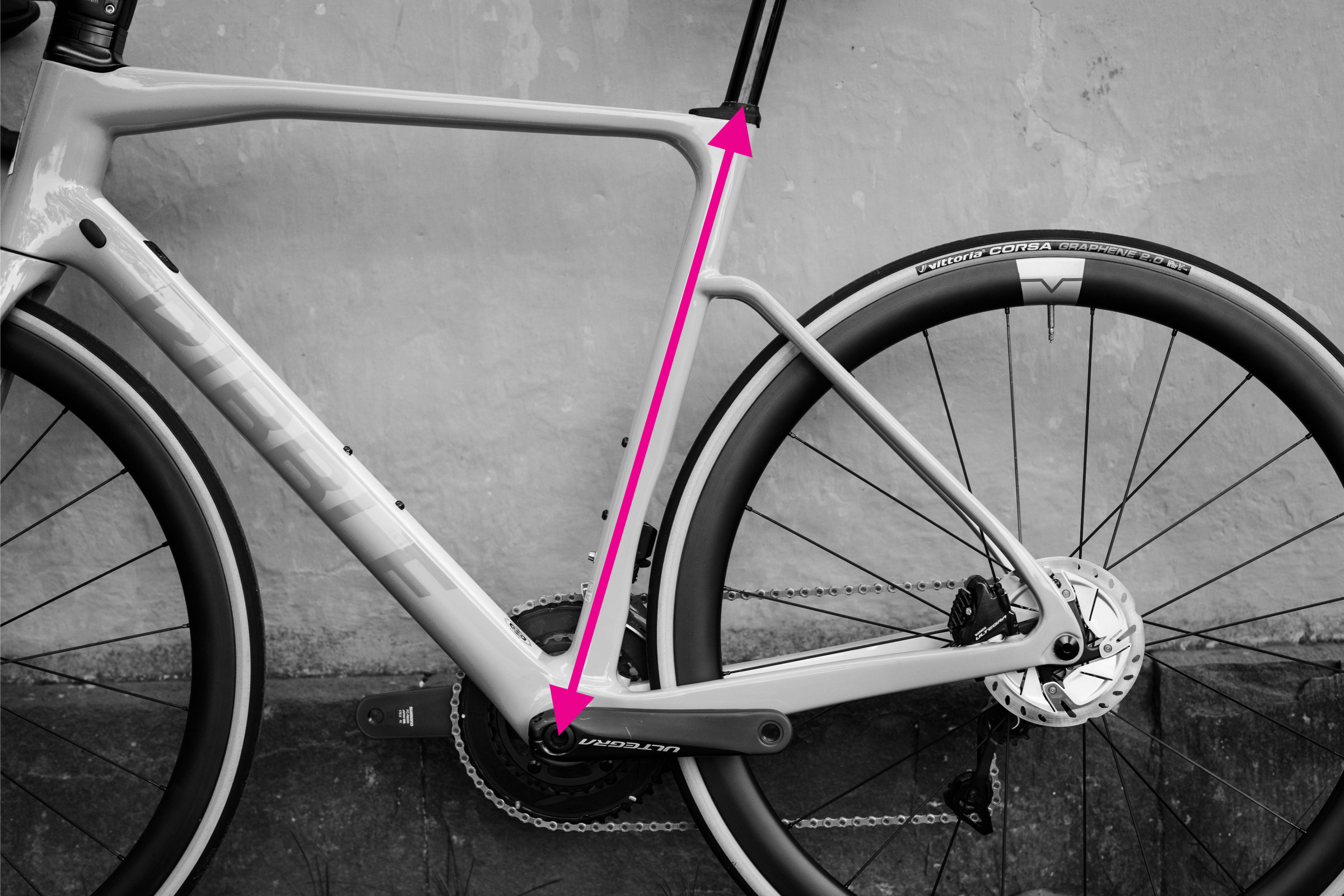 Seat tube measurement demonstrated on a bicycle frame
Seat tube measurement demonstrated on a bicycle frame
Seat tube length is measured as the straight-line distance from the center of the bottom bracket to the top of the seat tube. While seemingly straightforward, various frame designs can complicate direct comparisons.
For example, bikes like the Trek Madone feature a significant seat tube extension above the top tube junction, while others utilize seatmasts, making direct seat tube length comparisons less meaningful. Furthermore, mountain bikes often have curved or kinked seat tubes. In these cases, avoid simply following the curve of the tube, as this will yield an inaccurate, longer measurement.
To ensure accuracy, align your straight edge from the center of the bottom bracket to the top of the seat tube and measure along this straight line. This provides the true seat tube length, regardless of tube shape.
How to Measure Reach and Stack
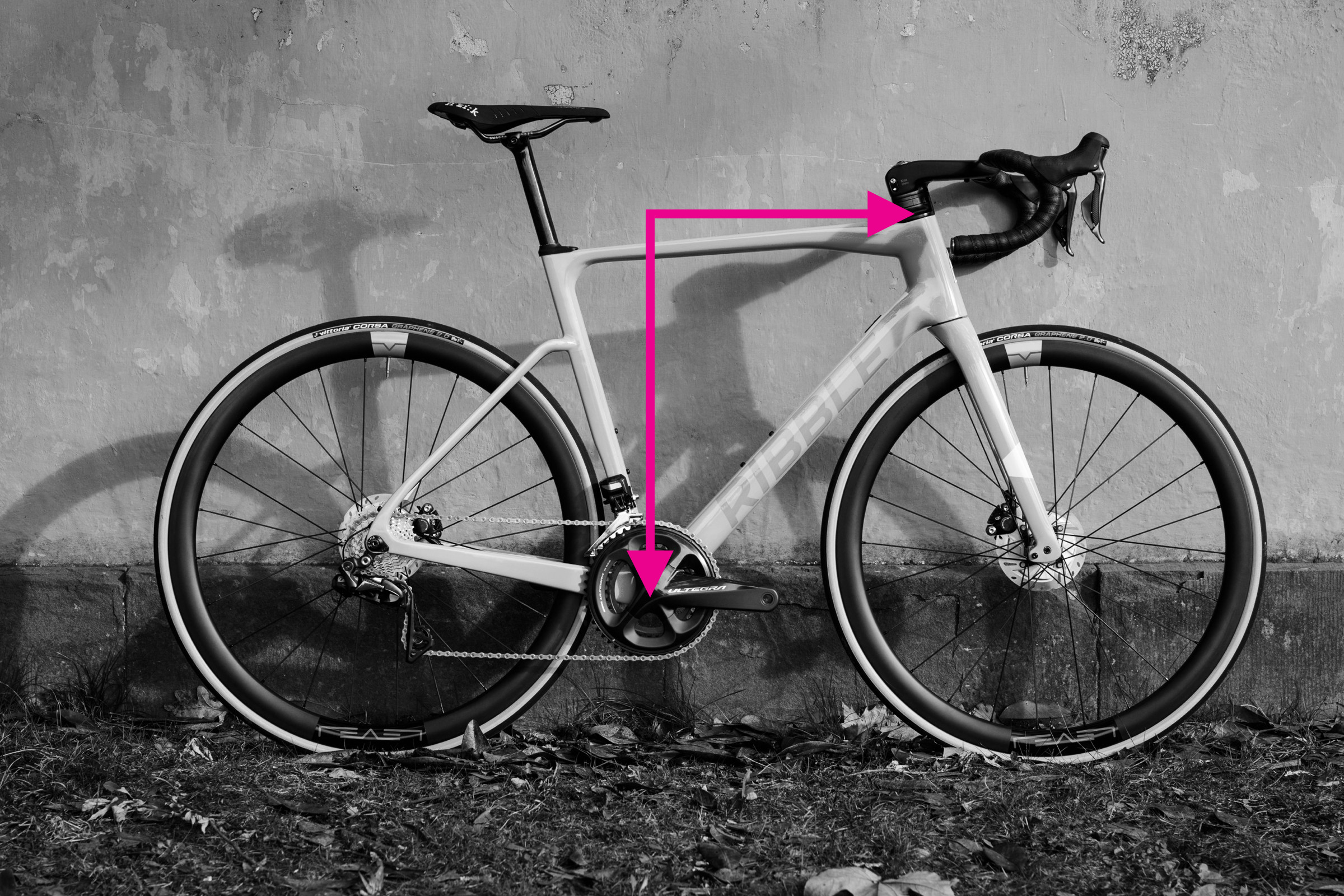 Stack and reach measurement demonstrated on a bike frame
Stack and reach measurement demonstrated on a bike frame
As we’ve seen, top tube length and seat tube length can be somewhat ambiguous when comparing frames due to varying design philosophies. For greater consistency and a more direct representation of frame size and rider positioning, most bike manufacturers now provide reach and stack values in their geometry charts.
Reach and stack offer a significant advantage because they are independent of traditional frame geometry and directly measure the perpendicular distances between two key contact points: the bottom bracket and the top of the head tube.
For a more in-depth explanation of the importance of reach and stack, you can read our article on why your top tube length is irrelevant.
In short, reach is the horizontal distance between the bottom bracket and the top of the head tube. To measure it:
- Use your spirit level and attach a plumb line to one end.
- Align the top edge of the spirit level with the centerline of the top of the head tube.
- Adjust the level until the plumb line hangs directly over the center of the bottom bracket spindle.
- Measure the horizontal distance from the top of the plumb line (where it meets the spirit level) back to the head tube. This distance is your reach.
Another method is to lean your bike against a wall. Measure the horizontal distance from the wall to the top of the head tube and then the horizontal distance from the wall to the bottom bracket. The difference between these two measurements is the reach. Ensure your measurements are horizontal for accuracy.
Stack is the vertical distance between the bottom bracket and the top of the head tube. Once you have your setup for measuring reach with the plumb line, you can also measure stack. The vertical distance from the top of the head tube down to the point on the spirit level directly above the bottom bracket represents the stack.
Alternatively, measure the vertical distance from the ground to the top of your head tube and then measure the vertical distance from the ground to the bottom bracket. Subtracting the bottom bracket height from the head tube height gives you the stack.
Both reach and stack measurements can be a little tricky to obtain precisely. Having a second person assist you, especially with the plumb line method, can be helpful. Repeating the measurements a few times will also help ensure consistency and accuracy.
How to Measure Wheelbase
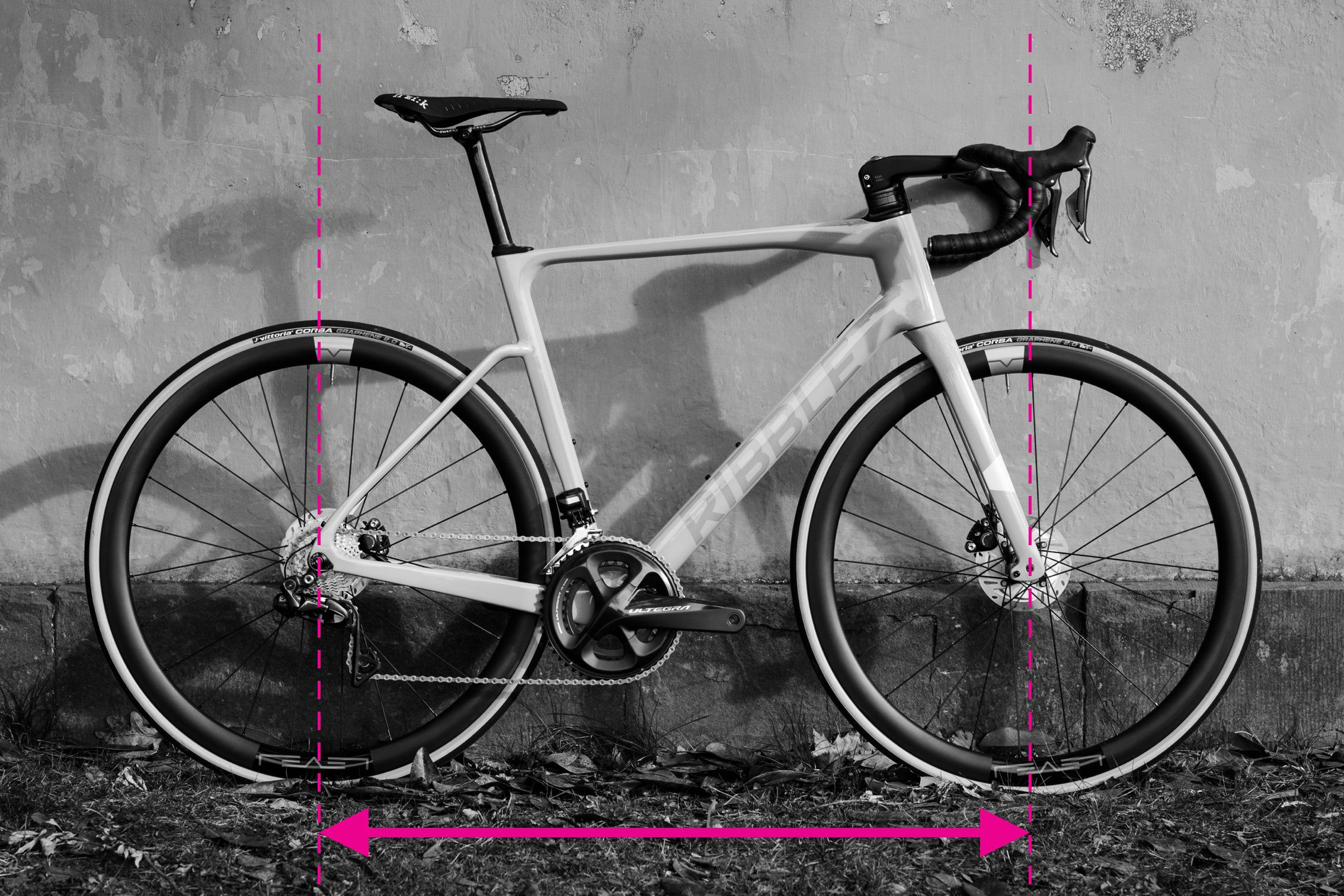 Wheelbase measurement demonstrated on a bike frame
Wheelbase measurement demonstrated on a bike frame
Your bike frame’s wheelbase is the distance between the front and rear axles. Wheelbase is a significant determinant of a bike’s ride characteristics and naturally varies with frame size.
Measuring wheelbase is relatively straightforward. Ensure your front fork is pointed straight ahead to avoid skewed measurements. Measure the distance from the center of the front axle to the center of the rear axle.
Similar to reach and stack, it’s advisable to repeat the wheelbase measurement a few times to confirm consistency. For enhanced accuracy, measure the wheelbase on both sides of the bike and calculate the average. This compensates for any slight misalignment of the fork.
How to Measure Chainstay Length
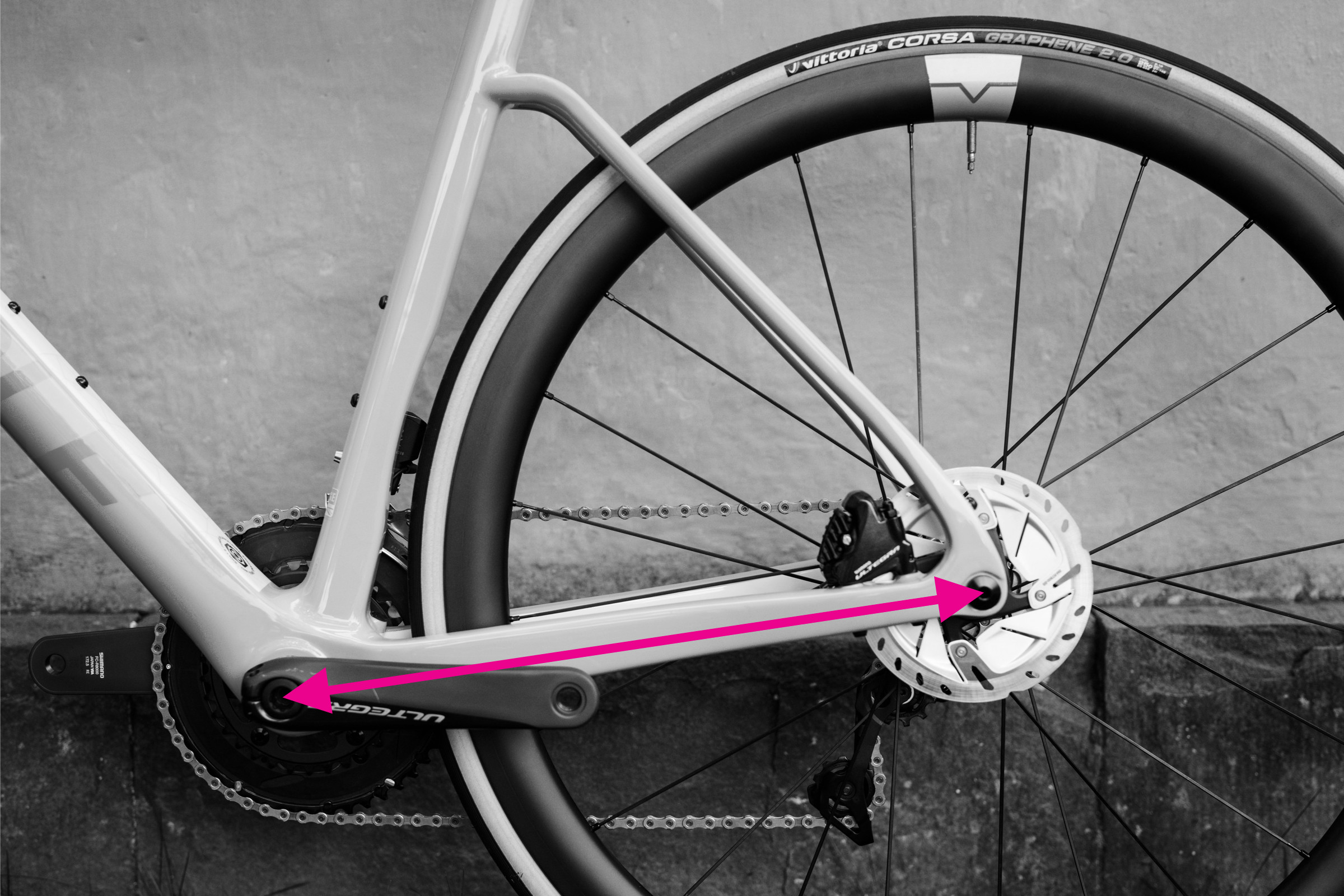 Chainstay length measurement demonstrated on a bike frame
Chainstay length measurement demonstrated on a bike frame
Chainstay length is one of the two primary components that constitute the wheelbase. It significantly influences a bike’s handling. Frames with shorter chainstays generally feel more agile and responsive, while longer chainstays tend to offer greater stability.
Chainstay length is measured as the straight-line distance from the center of the bottom bracket axle to the center of the rear dropout (where the rear wheel axle sits). This measurement is easily obtained with a ruler or tape measure.
How to Measure Front Center
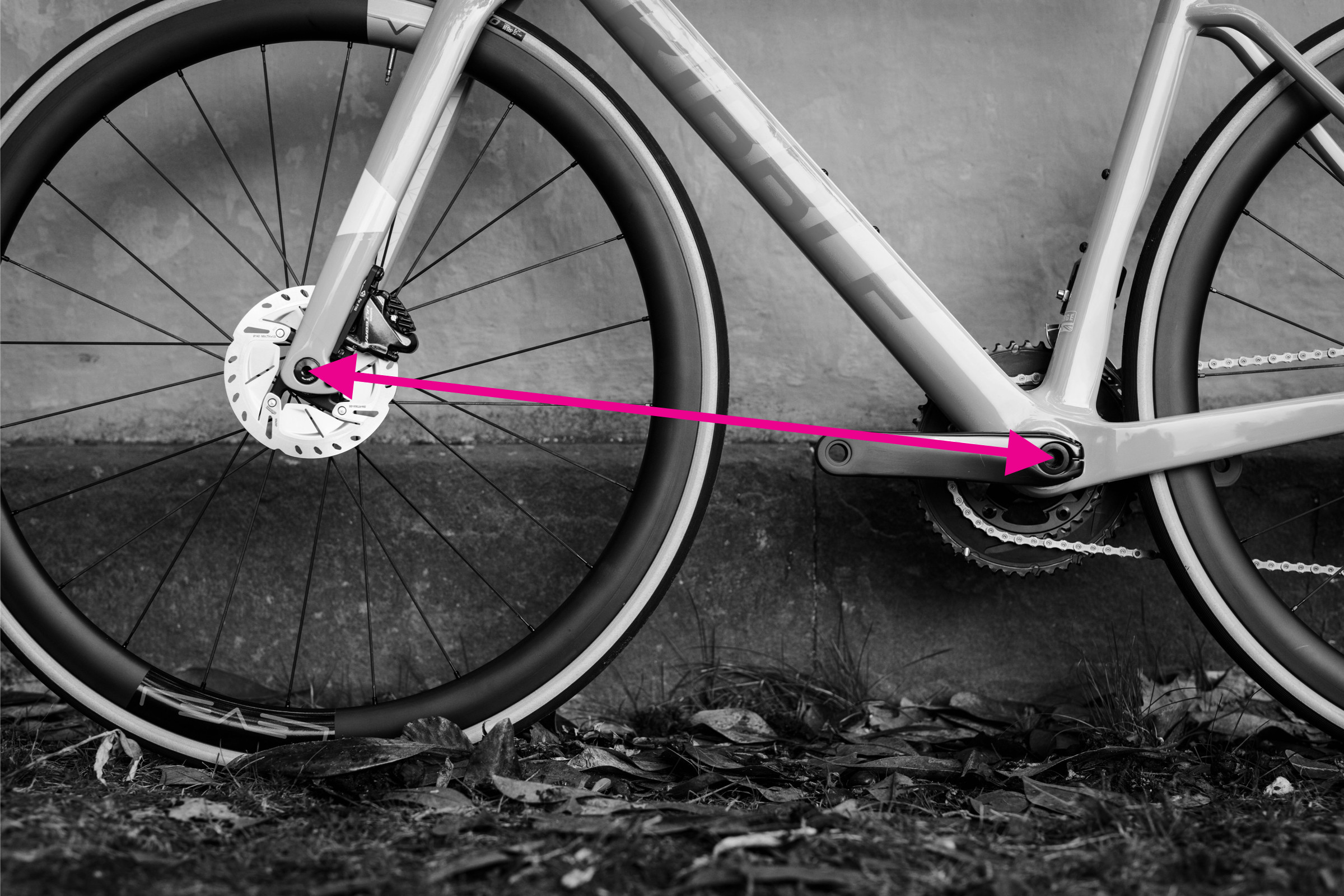 Front centre measurement demonstrated on a bike frame
Front centre measurement demonstrated on a bike frame
The other key component of the wheelbase is the front center. Front center is analogous to chainstay length, but measured from the center of the bottom bracket to the center of the front dropout.
Front center also plays a role in bike handling characteristics and is a factor in determining toe overlap—the extent to which your shoe might contact the front wheel during tight turns. While not as frequently listed as other measurements, some manufacturers, like BMC, include front center in their geometry charts.
It’s important to remember that the wheelbase is not simply the sum of chainstay length and front center. This is because neither of these measurements is taken along a purely horizontal plane. They are components that, when combined geometrically, result in the overall wheelbase.
How to Measure Seat Tube and Head Tube Angles
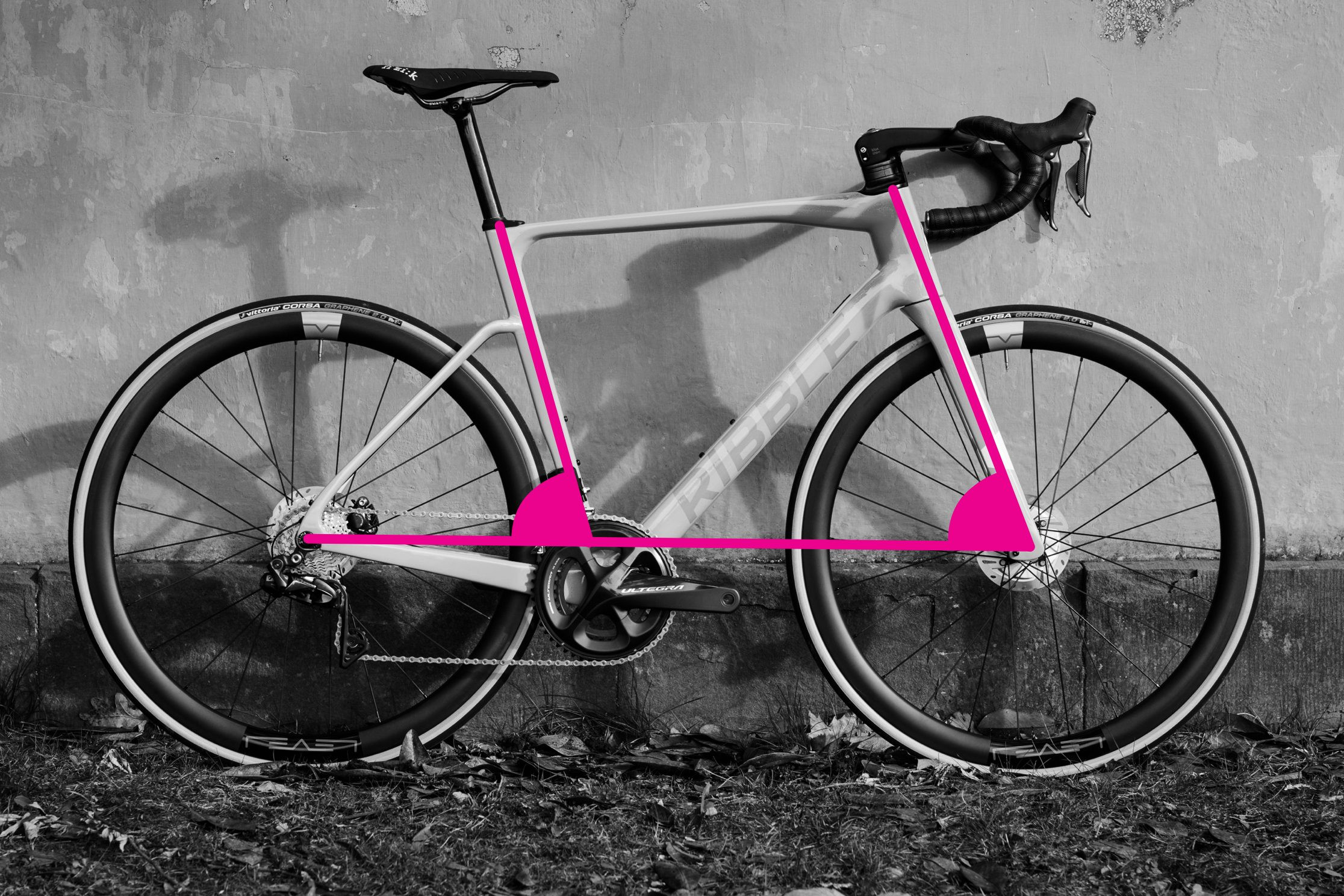 Seat and head tube measurements demonstrated on a bike frame
Seat and head tube measurements demonstrated on a bike frame
Seat tube angle and head tube angle are critical factors influencing a bike’s handling dynamics. Steeper (more upright) tube angles typically contribute to quicker, more nimble handling, while slacker angles often result in greater stability, especially at higher speeds. Your clinometer app is invaluable for measuring these angles.
To measure seat tube angle:
- If your seat tube is straight, simply place your smartphone directly against the seat tube.
- Open your clinometer app and read the angle.
- Ensure your bike is standing vertically on a level surface for accurate readings.
If your seat tube has a curve or kink, use a straight edge to create a straight line extending along the main section of the seat tube, between the bottom bracket shell and the top of the seat tube. Place your phone against this straight edge and measure the angle.
For head tube angle:
- Many modern bikes feature tapered head tubes, meaning the front face angle may differ slightly from the centerline angle.
- To approximate the centerline angle, try to align your phone with the visual centerline of the head tube.
- Alternatively, use a straight edge to connect the centers of the top and bottom of the head tube and measure the angle along this straight edge.
- If your bike has straight fork legs (without a curved crown), the angle of the fork legs will closely match the head tube angle. You can measure the angle of the fork legs instead.
- Another approach is to measure the angle of the steerer tube extension above the head tube.
Again, ensure the bike is vertical for accurate angle measurements.
How to Measure Bottom Bracket Drop
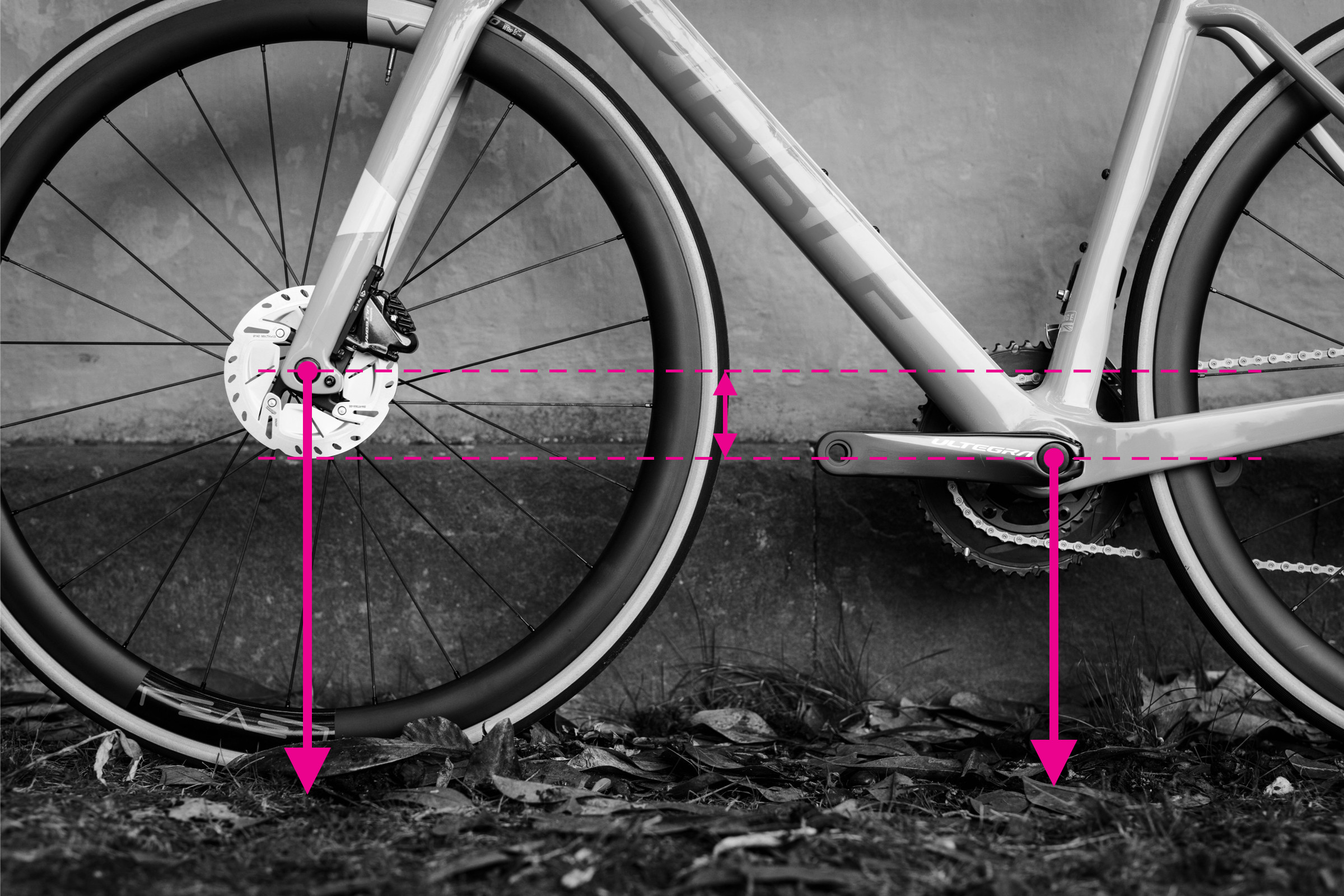 BB drop measurement demonstrated on a bike frame
BB drop measurement demonstrated on a bike frame
Bottom bracket drop is the vertical distance that the center of the bottom bracket sits below the horizontal line connecting the wheel axles. Bottom bracket drop is another key geometry measurement often provided by bike manufacturers.
To measure bottom bracket drop:
- Measure the vertical distance from the ground to the rear wheel axle (rear hub center).
- Measure the vertical distance from the ground to the center of the bottom bracket.
- Subtract the wheel axle height from the bottom bracket height. The result is the bottom bracket drop.
Bottom bracket drop influences a bike’s stability and cornering characteristics. A larger bottom bracket drop generally lowers the rider’s center of gravity, contributing to enhanced stability.
How to Measure Bottom Bracket Height
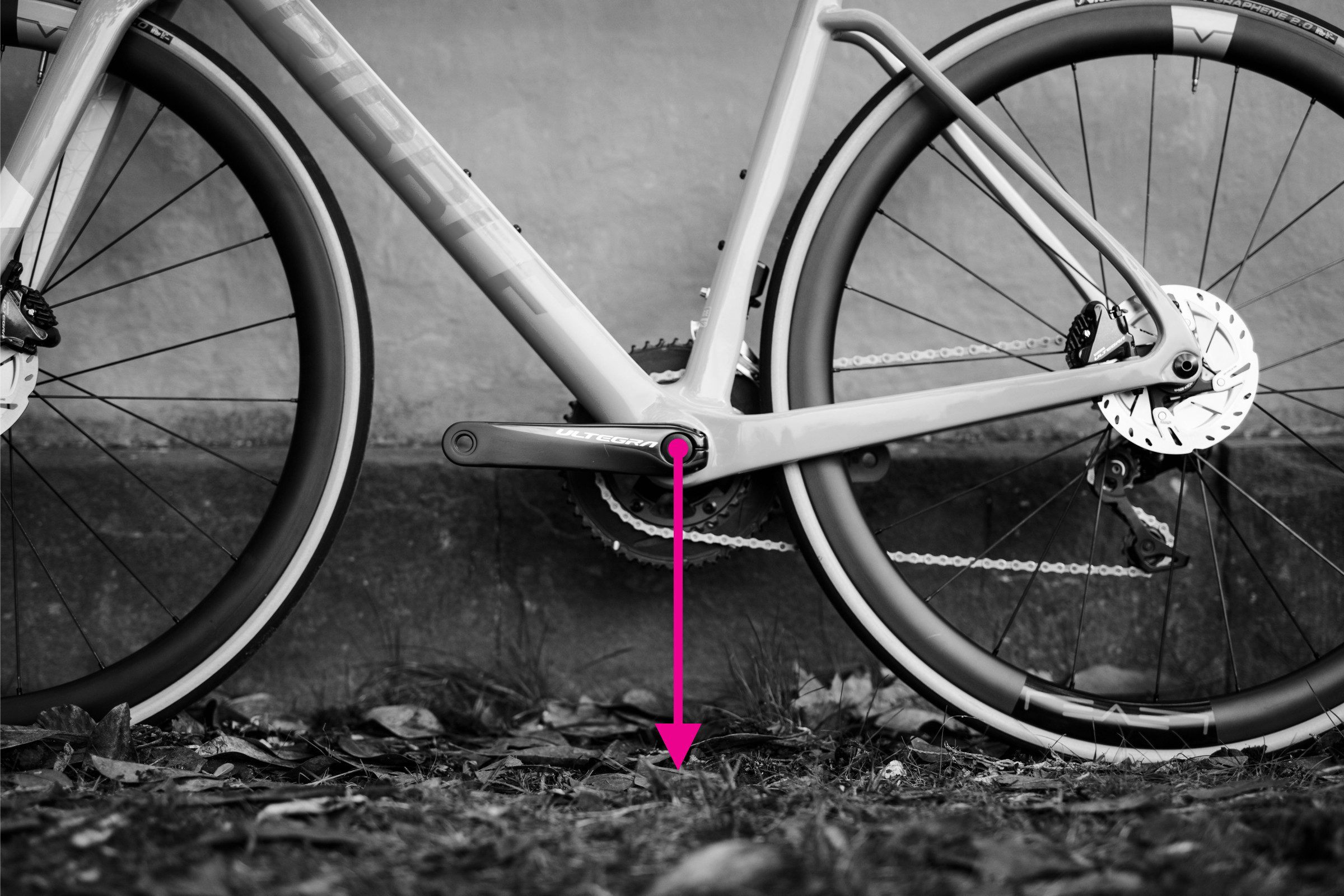 Bottom bracket height measurement demonstrated on bike frame
Bottom bracket height measurement demonstrated on bike frame
Finally, bottom bracket height is simply the vertical distance from the ground to the center of the bottom bracket shell.
Measuring bottom bracket height is quite straightforward. Carefully measure the vertical distance from the ground to the center of the bottom bracket. Ensure your bike is standing upright for an accurate measurement.
Unlike bottom bracket drop, bottom bracket height can be slightly influenced by tire size and pressure. For the most consistent measurements, inflate your tires to your typical riding pressure before measuring bottom bracket height.
With these measurements in hand, you are now equipped to effectively assess bike frame sizes. This knowledge will be invaluable for future bike purchasing decisions, whether you’re considering a new or second-hand road bike, a commuting bike, or a versatile gravel bike. Store your measurements in a safe place for easy access – you’ll be glad you have them when the time comes to choose your next ride!

